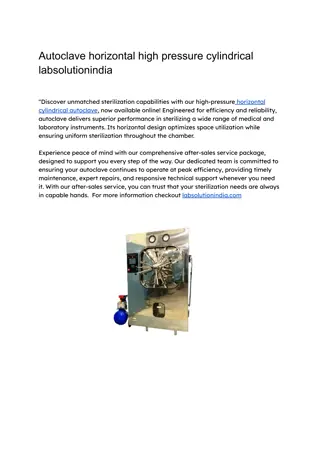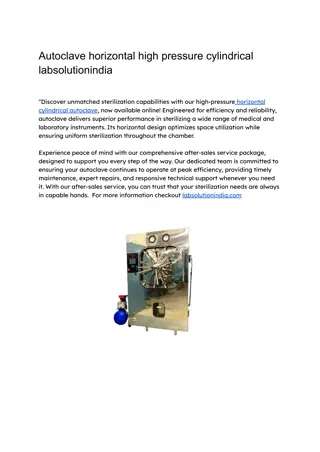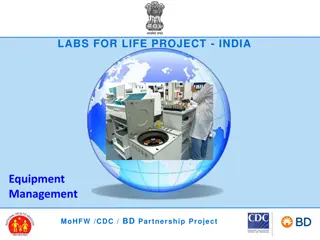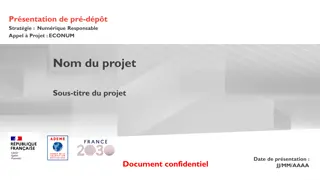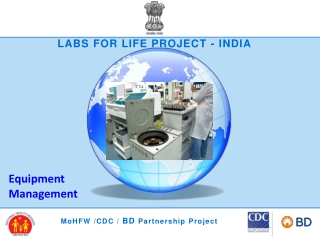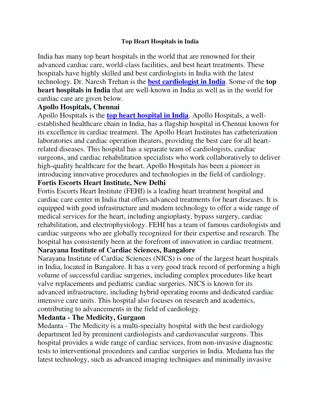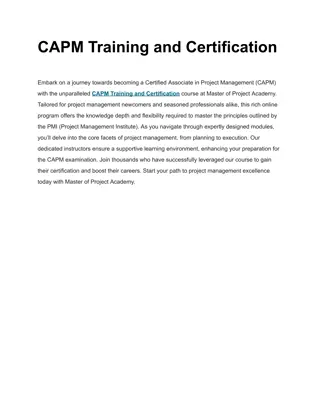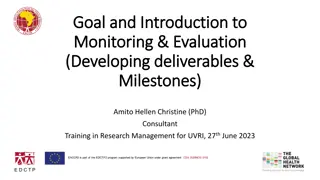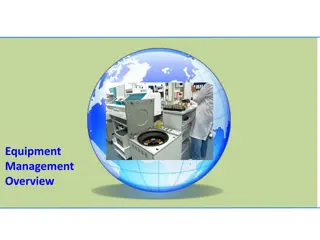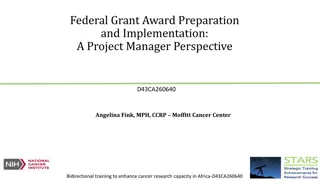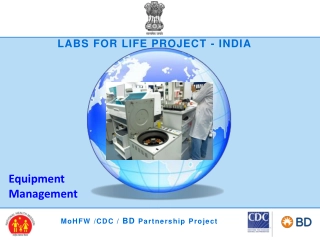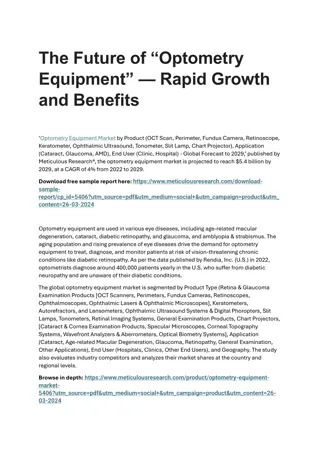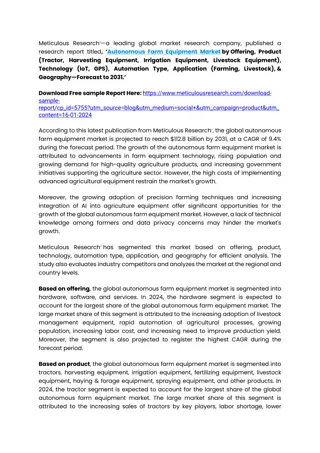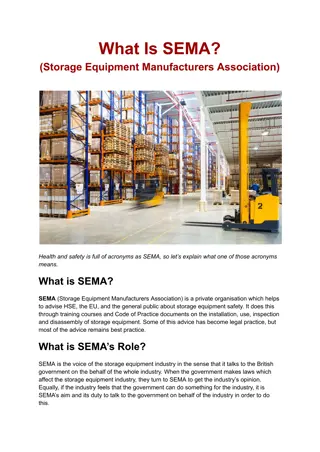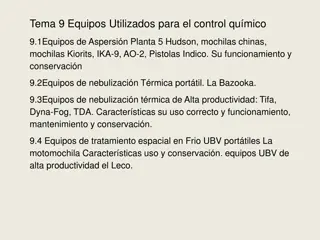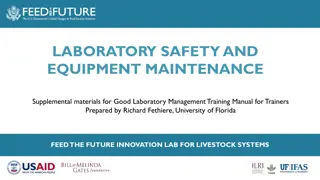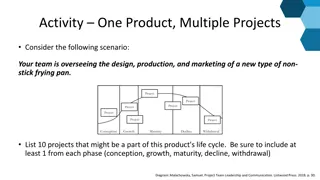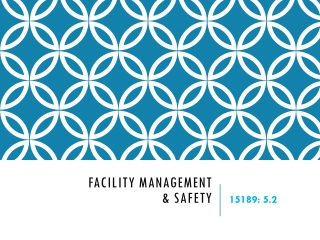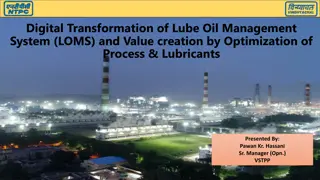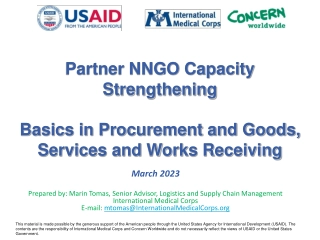Autoclave Equipment Management in Labs for Life Project India
Autoclave is a key sterilizing equipment used to eliminate all forms of life from lab materials. It operates on steam or moist heat sterilization principles, reaching temperatures higher than 100°C. Proper maintenance, including following SOPs, checking temperature and pressure, and conducting routine verifications, is crucial for its effective operation in labs.
Autoclave Equipment Management in Labs for Life Project India
PowerPoint presentation about 'Autoclave Equipment Management in Labs for Life Project India'. This presentation describes the topic on Autoclave is a key sterilizing equipment used to eliminate all forms of life from lab materials. It operates on steam or moist heat sterilization principles, reaching temperatures higher than 100°C. Proper maintenance, including following SOPs, checking temperature and pressure, and conducting routine verifications, is crucial for its effective operation in labs.. Download this presentation absolutely free.
Presentation Transcript
LABS FOR LIFE PROJECT - INDIA Equipment Management MoHFW /CDC / BD Partnership Project
Autoclave Introduction The autoclave is a sterilizing equipment. The word sterilizing means the destruction or elimination of all forms of life. Depending on how they operate, it is possible to find manual, semiautomatic or fully automatic models. The smallest are the table-top type and the largest are complex equipment that require significant pre-installation for their operation. Purpose To prepare materials for bacteriological cultures (test tubes, pipettes, petri dishes, etc.) in order to avoid their contamination. Sterilize contaminated material.
Autoclave Principle: Steam or moist heat sterilization. Based on thermodynamic properties of water Autoclaves use pressurized saturated vapor for transmitting thermal energy. In normal conditions (at sea level and pressure of 1 atmosphere) water (in liquid phase) boils and is converted into vapor (gaseous phase) at a 100 C. If the pressure is reduced, it boils at a lower temperature. If the pressure rises, it boils at a greater temperature. Through the control of water vapor pressure, the autoclave can, in its sealed chamber, reach temperatures higher than 100 C Most steam sterilizers are designed to operate at 121 C for 15 minutes at 2500m and at 125 C at sea level, therefore use 15 minutes up to 2500 m; between 2500m and 7000m, use 30 minutes.
Autoclave Important Practical Tips: Prepare written SOPs covering the use, care, and maintenance of the autoclave Hold in stock a spare lid gasket, safety valve, and spare valve washers (seals). Do not mix loads, i.e. autoclave infectious material separate from noninfectious articles. Always use the correct volume of water in the autoclave each time it is used (it must not be allowed to boil dry). Leave sufficient space between articles for the steam to circulate freely Do not open the sterilizer until it has cooled and totally vented Place a control TST strip (chemical indicator )in the center of the load where steam penetration is likely to be slowest. TST strips incorporate a yellow chemical indicator in a circular area on the end of each strip. When conditions for sterilization have been met, the yellow color of the indicator dot change to a purple-blue color Biologic indicator of Sterilization process -Spores of Bacillus stearothermophilus are generally used.
Autoclave Important routine verifications Check that the: Required temperature & pressure are sustained during operation. Pressure gauge is in working order and reading zero at atmospheric pressure. Safety valve is free moving and in working order Valves are undamaged and working correctly with no leakage from seals. Manometer & thermometer is working optimally
Autoclave Maintenance An autoclave demands continuous maintenance due to its multiple components and systems Clean all the filters. Change the air filter as required Dismount, clean and adjust the safety valves. Conduct a general sterilization process testing in detail the pressure, temperature, required times for completing each phase of the cycle, state of the process signal lamps and overall functioning of the system. Calibration Maximum period between successive calibration & checks should be one year. Check on effectiveness of sterilization with each cycle (NABL 112).
Autoclave Safety To avoid fluids boiling and injuries from burns or exploding bottles, NEVER open the draw-off cock or aircock, or attempt to open the lid of an autoclave until the temperature has fallen to below 80 C and the PRESSURE READS ZERO (Some models of electric autoclave are fitted with a safety device that prevents opening when the autoclave is still under pressure or thermal lock.) Wear full face and hand protection when opening and unpacking an autoclave, particularly when it contains bottled fluids which may still be over 100 C even when the temperature inside the autoclave is below 80 C. On contact with air at room temperature the bottle may explode. If possible, leave the autoclave to cool overnight before opening it.


